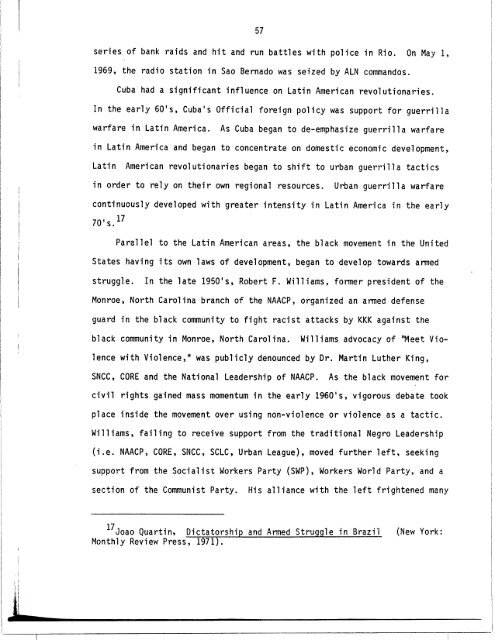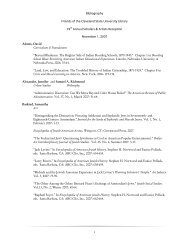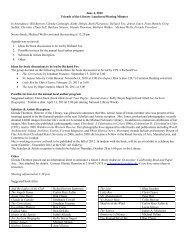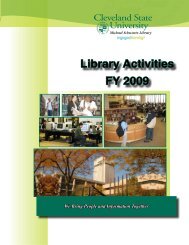revolutionary action movement (ram) - Michael Schwartz Library
revolutionary action movement (ram) - Michael Schwartz Library
revolutionary action movement (ram) - Michael Schwartz Library
You also want an ePaper? Increase the reach of your titles
YUMPU automatically turns print PDFs into web optimized ePapers that Google loves.
57<br />
series of bank raids and hit and run battles with police in Rio . On May 1,<br />
1969, the radio station in Sao Bernado was seized by ALN commandos .<br />
Cuba had a significant influence on Latin American revolutionaries .<br />
In<br />
the early 60's, Cuba's Official foreign policy was support for guerrilla<br />
warfare in Latin America . As Cuba began to de-emphasize guerrilla warfare<br />
in Latin America and began to concentrate on domestic_ economic development,<br />
Latin<br />
American revolutionaries began to shift to urban guerrilla tactics<br />
in order to rely on their own regional resources . Urban guerrilla warfare<br />
continuously developed with greater intensity in Latin America in the early<br />
70's . 17<br />
Parallel<br />
to the Latin American areas, the black <strong>movement</strong> in the United<br />
States having its<br />
own laws of development, began to develop towards armed<br />
struggle . In the late 1950's, Robert F . Williams, former president of the<br />
Monroe, North Carolina branch of the NAACP, organized an armed defense<br />
guard in the black community to fight racist attacks by KKK against the<br />
black community in Monroe, North Carolina .<br />
Williams advocacy of "Meet Violence<br />
with Violence," was publicly denounced by Dr .<br />
Martin Luther King,<br />
SNCC, CORE and the National Leadership of NAACP . As the black <strong>movement</strong> for<br />
civil rights gained mass momentum in the early 1960's, vigorous debate took<br />
place inside the <strong>movement</strong> over using non-violence or violence as a tactic .<br />
Williams, failing to receive support from the traditional Negro Leadership<br />
(i .e . NAACP, CORE, SNCC, SCLC, Urban League), moved further left, seeking<br />
support from the Socialist Workers Party (SWP), Workers World Party, and a<br />
section of the Communist Party . His alliance with the left frightened many<br />
17 Joao Quartin, Dictatorship and Armed Struggle in Brazil (New York :<br />
Monthly Review Press, 1971) .








